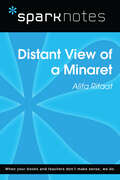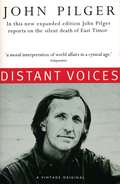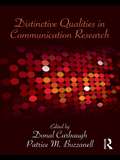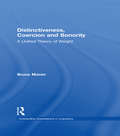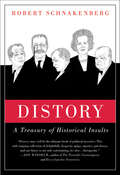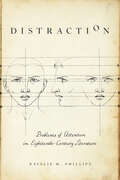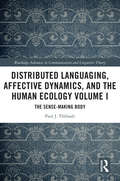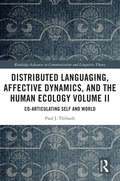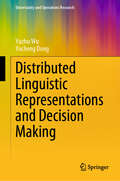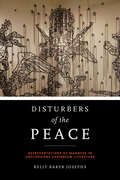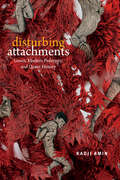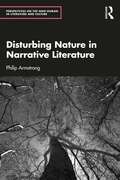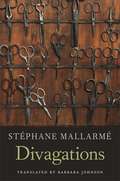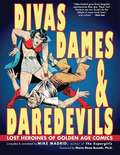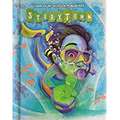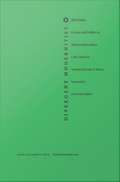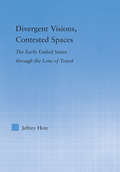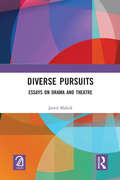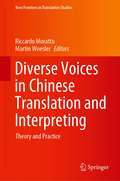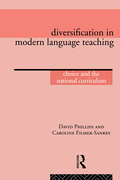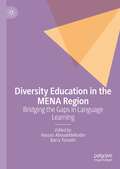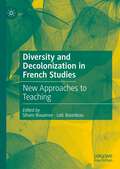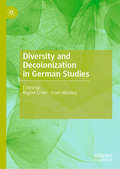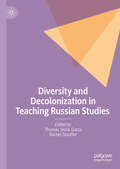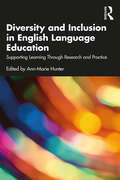- Table View
- List View
Distant View of a Minaret (SparkNotes Literature Guide Series)
by SparkNotesDistant View of a Minaret (SparkNotes Literature Guide) by Alifa Rifaat Making the reading experience fun! Created by Harvard students for students everywhere, SparkNotes is a new breed of study guide: smarter, better, faster.Geared to what today's students need to know, SparkNotes provides:chapter-by-chapter analysis explanations of key themes, motifs, and symbols a review quiz and essay topics Lively and accessible, these guides are perfect for late-night studying and writing papers.
Distant Voices
by John PilgerThroughout his distinguished career as a journalist and film-maker, John Pilger has looked behind the 'official' versions of events to report the real stories of our time.The centrepiece of this new, expanded edition of his bestselling Distant Voices is Pilger's reporting from East Timor, which he entered secretly in 1993 and where a third of the population has died as a result of Indonesia's genocidal policies. This edition also contains more new material as well as all the original essays - from the myth-making of the Gulf War to the surreal pleasures of Disneyland. Breaking through the consensual silence, Pilger pays tribute to those dissenting voices we are seldom permitted to hear.
Distinctive Qualities in Communication Research
by Patrice M. Buzzanell Donal CarbaughThis timely volume provides an in-depth look at why the field of communication is so central in initiatives for social impact around the world. In Distinctive Qualities in Communication Research, editors Donal Carbaugh and Patrice M. Buzzanell bring together scholars with varied and productive approaches to communication to address the question of what distinguishes communication research from similar studies in other disciplines. Each contributor responds to the question: "What makes your research communication research? How does your program of inquiry treat communication not simply as data, but as its primary theoretical concern?" Their responses are the heart of this book. The questions addressed and answered herein define the qualities that set research in communication apart from work in related fields, such as social psychology, linguistics, sociology, anthropology, and psychology. The book begins and ends by looking across these studies generally, bringing into view not only the specific possibilities in the study of communication today, but also what such study contributes generally to understanding human problems, social relations, and communities. This volume provides an invaluable resource for graduate students beginning their study in communication; academics needing to define the distinctive contributions that communication research makes; and administrators who want to understand the scope and breadth of work in communication. It provides an invaluable resource for defining the role of communication research in the academic community and the contributions it makes to the study of human interaction.
Distinctiveness, Coercion and Sonority: A Unified Theory of Weight (Outstanding Dissertations in Linguistics)
by Bruce MorenThis volume proposes a unified weight theory that challenges traditionally held beliefs regarding the vowel/consonant dichotomy inherent in moraicity and illuminates many previously intractable issues.
Distory: A Treasury of Historical Insults
by Robert SchnakenbergDistory: A Treasury of Historical Insults is a hilarious collection of insulting historical quotations in the vein of The Portable Curmudgeon that will have history buffs and readers of humor books in stitches. Full of lively quips, jabs, jaunts and put downs by and about notable figures, it covers all epochs of mostly Western history. Schnakenberg has collected more than 600 historical insults into this first collection of its kind.Included:"A German singer! I should as soon expect to get pleasure from the neighing of my horse."- Alexander the Great"Belgium is just a country invented by the British to annoy the French." - Charles de Gaulle"What can you do with a man who looks like a female llama surprised when bathing?"- Winston Churchill on Charles de Gaulle"Jerry Ford is so dumb he can't fart and chew gum at the same time." - Lyndon B. Johnson"Avoid all needle drugs - -the only dope worth shooting is Richard Nixon." - Abbie Hoffman
Distraction: Problems of Attention in Eighteenth-Century Literature
by Natalie M. PhillipsEnlightenment writers fiercely debated the nature of distraction in literature.Early novel reading typically conjures images of rapt readers in quiet rooms, but commentators at the time described reading as a fraught activity, one occurring amidst a distracting cacophony that included sloshing chamber pots and wailing street vendors. Auditory distractions were compounded by literary ones as falling paper costs led to an explosion of print material, forcing prose fiction to compete with a dizzying array of essays, poems, sermons, and histories. In Distraction, Natalie M. Phillips argues that prominent Enlightenment authors—from Jane Austen and William Godwin to Eliza Haywood and Samuel Johnson—were deeply engaged with debates about the wandering mind, even if they were not equally concerned about the problem of distractibility.Phillips explains that some novelists in the 1700s—viewing distraction as a dangerous wandering from singular attention that could lead to sin or even madness—attempted to reform diverted readers. Johnson and Haywood, for example, worried that contemporary readers would only focus long enough to "look into the first pages" of essays and novels; Austen offered wry commentary on the issue through the creation of the daft Lydia Bennet, a character with an attention span so short she could listen only "half-a-minute." Other authors radically redefined distraction as an excellent quality of mind, aligning the multiplicity of divided focus with the spontaneous creation of new thought. Laurence Sterne’s Tristram Shandy, for example, won audiences with its comically distracted narrator and uniquely digressive form.Using cognitive science as a framework to explore the intertwined history of mental states, philosophy, science, and literary forms, Phillips explains how arguments about the diverted mind made their way into the century’s most celebrated literature. She also draws a direct link between the disparate theories of focus articulated in eighteenth-century literature and modern experiments in neuroscience, revealing that contemporary questions surrounding short attention spans are grounded in long conversations over the nature and limits of focus.
Distributed Languaging, Affective Dynamics, and the Human Ecology Volume I: The Sense-making Body (Routledge Advances in Communication and Linguistic Theory)
by Paul J. ThibaultLanguage plays a central role in human life. However, the term ‘language’ as defined in the language sciences of the 20th century and the traditions these have drawn on, have arguably, limited our thinking about what language is and does. The two inter-linked volumes of Thibault’s study articulate crucially important aspects of an emerging new perspective shift on language - the Distributed Language view – that is now receiving more and more attention internationally. Rejecting the classical view that the fundamental architecture of language can be localized as a number of inter-related levels of formal linguistic organization that function as the coded inputs and outputs to each other, the distributed language view argues that languaging behaviour is a bio-cultural organisation of process that is embodied, multimodal, and integrated across multiple space-time scales. Thibault argues that we need to think of human languaging as the distinctively human mode of our becoming and being selves in the extended human ecology and the kinds of experiencing that this makes possible. Paradoxically, this also means thinking about language in non-linguistic ways that break the grip of the conventional meta-languages for thinking about human languaging. Thibault’s book grounds languaging in process theory: languaging and the forms of experience it actualizes is always an event, not a thing that we ‘use’. In taking a distinctively interdisciplinary approach, the book relates dialogical theories of human sense-making to the distributed view of human cognition, to recent thinking about distributed language, to ecological psychology, and to languaging as inter-individual affective dynamics grounded in the subjective lives of selves. In taking this approach, the book considers the coordination of selves in social encounters, the emergent forms of self-reflexivity that characterise these encounters, and the implications for how we think of and live our human sociality, not as something that is mediated by over-arching codes and systems, but as emerging from the endogenous subjectivities of selves when they seek to coordinate with other selves and with the situations, artefacts, social institutions, and technologies that populate the extended human ecology. The two volumes aim to bring our understanding of human languaging closer to human embodiment, experience, and feeling while also showing how languaging enables humans to transcend local circumstances and thus to dialogue with cultural tradition. Volume 1 focuses on the shorter timescales of bodily dynamics in languaging activity. Volume II integrates the shorter timescales of body dynamics to the longer cultural-historical timescales of the linguistic and cultural norms and patterns to which bodily dynamics are integrated.
Distributed Languaging, Affective Dynamics, and the Human Ecology Volume II: Co-articulating Self and World (Routledge Advances in Communication and Linguistic Theory)
by Paul J. ThibaultLanguage plays a central role in human life. However, the term "language" as defined in the language sciences of the 20th century and the traditions these have drawn on, have arguably limited our thinking about what language is and does. The two inter-linked volumes of Thibault’s study articulate crucially important aspects of an emerging new perspective shift on language—the Distributed Language view—that is now receiving more and more attention internationally. Rejecting the classical view that the fundamental architecture of language can be localised as a number of inter-related levels of formal linguistic organisation that function as the coded inputs and outputs to each other, the distributed language view argues that languaging behaviour is a bio-cultural organiation of process that is embodied, multimodal, and integrated across multiple space-time scales. Thibault argues that we need to think of human languaging as the distinctively human mode of our becoming and being selves in the extended human ecology and the kinds of experiencing that this makes possible. Paradoxically, this also means thinking about language in non-linguistic ways that break the grip of the conventional meta-languages for thinking about human languaging. Thibault’s book grounds languaging in process theory: languaging and the forms of experience it actualises is always an event, not a thing that we "use". In taking a distinctively interdisciplinary approach, the book relates dialogical theories of human sense-making to the distributed view of human cognition, to recent thinking about distributed language, to ecological psychology, and to languaging as inter-individual affective dynamics grounded in the subjective lives of selves. In taking this approach, the book considers the coordination of selves in social encounters, the emergent forms of self-reflexivity that characterise these encounters, and the implications for how we think of and live our human sociality, not as something that is mediated by over-arching codes and systems, but as emerging from the endogenous subjectivities of selves when they seek to coordinate with other selves and with the situations, artefacts, social institutions, and technologies that populate the extended human ecology. The two volumes aim to bring our understanding of human languaging closer to human embodiment, experience, and feeling while also showing how languaging enables humans to transcend local circumstances and thus to dialogue with cultural tradition. Volume I focuses on the shorter timescales of bodily dynamics in languaging activity. Volume II integrates the shorter timescales of body dynamics to the longer cultural–historical timescales of the linguistic and cultural norms and patterns to which bodily dynamics are integrated.
Distributed Linguistic Representations and Decision Making (Uncertainty and Operations Research)
by Yucheng Dong Yuzhu WuThis book provides a comprehensive perspective on the development of distributed linguistic representations in decision making, including the taxonomy of existing distributed linguistic representations, the key elements, and the classifications. It systematically investigates the formation of distributed linguistic representations and the methodology for the distributed linguistic information transformations and unifications, as well as the fusion and consensus reaching. This book studies the distributed linguistic information in MADM and the PIS-based applications of distributed linguistic information processing in decision making. Distributed linguistic representations are powerful tools for modelling the uncertainty and complexity of preference information in linguistic decision making. This book is written for researchers and postgraduates interested in linguistic decision making. Readers will find out lots of clear cues for distributed linguistic representations and distributed linguistic methodology to support decision making.
Disturbers of the Peace: Representations of Madness in Anglophone Caribbean Literature (New World Studies)
by Kelly Baker JosephsExploring the prevalence of madness in Caribbean texts written in English in the mid-twentieth century, Kelly Baker Josephs focuses on celebrated writers such as Jean Rhys, V. S. Naipaul, and Derek Walcott as well as on understudied writers such as Sylvia Wynter and Erna Brodber. Because mad figures appear frequently in Caribbean literature from French, Spanish, and English traditions—in roles ranging from bit parts to first-person narrators—the author regards madness as a part of the West Indian literary aesthetic. The relatively condensed decolonization of the anglophone islands during the 1960s and 1970s, she argues, makes literature written in English during this time especially rich for an examination of the function of madness in literary critiques of colonialism and in the Caribbean project of nation-making. In drawing connections between madness and literature, gender, and religion, this book speaks not only to the field of Caribbean studies but also to colonial and postcolonial literature in general. The volume closes with a study of twenty-first-century literature of the Caribbean diaspora, demonstrating that Caribbean writers still turn to representations of madness to depict their changing worlds.
Disturbing Attachments: Genet, Modern Pederasty, and Queer History
by Kadji AminJean Genet (1910–1986) resonates, perhaps more than any other canonical queer figure from the pre-Stonewall past, with contemporary queer sensibilities attuned to a defiant non-normativity. Not only sexually queer, Genet was also a criminal and a social pariah, a bitter opponent of the police state, and an ally of revolutionary anticolonial movements. In Disturbing Attachments, Kadji Amin challenges the idealization of Genet as a paradigmatic figure within queer studies to illuminate the methodological dilemmas at the heart of queer theory. Pederasty, which was central to Genet's sexuality and to his passionate cross-racial and transnational political activism late in life, is among a series of problematic and outmoded queer attachments that Amin uses to deidealize and historicize queer theory. He brings the genealogy of Genet's imaginaries of attachment to bear on pressing issues within contemporary queer politics and scholarship, including prison abolition, homonationalism, and pinkwashing. Disturbing Attachments productively and provocatively unsettles queer studies by excavating the history of its affective tendencies to reveal and ultimately expand the contexts that inform the use and connotations of the term queer.
Disturbing Nature in Narrative Literature (Perspectives on the Non-Human in Literature and Culture)
by Philip ArmstrongDisturbing Nature in Narrative Literature identifies and analyses encounters with unexpected, disconcerting, and unsettling aspects of the natural world, as these have been represented across a wide range of literary texts. It includes in‑depth discussion of both familiar and less familiar works from the British, American, and European literary traditions, and from the Classical period to today. The motifs discussed include earthquakes, forests, storms, animals, and oceanic depth, and the writers include Virgil, Ovid, Dante, Shakespeare, Aphra Behn, Voltaire, Heinrich von Kleist, Herman Melville, H.G. Wells, J.R.R. Tolkien, Gabriel García Márquez, José Saramago, Margaret Atwood, and Annie Proulx. Rich in both close textual analysis and contextual discussion, Disturbing Nature in Narrative Literature offers a vivid introduction to several topical approaches to literary‑critical analysis, including ecocriticism, new materialism, affect theory, and human‑animal studies, thereby demonstrating how literature shapes and is shaped by our response to the pressing questions of our time.
Divagations
by Stéphane Mallarmé"This is a book just the way I don't like them," the father of French Symbolism, Stéphane Mallarmé, informs the reader in his preface to Divagations: "scattered and with no architecture." On the heels of this caveat, Mallarmé's diverting, discursive, and gorgeously disordered 1897 masterpiece tumbles forth--and proves itself to be just the sort of book his readers like most. The salmagundi of prose poems, prose-poetic musings, criticism, and reflections that is Divagations has long been considered a treasure trove by students of aesthetics and modern poetry. If Mallarmé captured the tone and very feel of fin-de-siècle Paris, he went on to captivate the minds of the greatest writers of the twentieth century--from Valéry and Eliot to Paul de Man and Jacques Derrida. This was the only book of prose he published in his lifetime and, in a new translation by Barbara Johnson, is now available for the first time in English as Mallarmé arranged it. The result is an entrancing work through which a notoriously difficult-to-translate voice shines in all of its languor and musicality. Whether contemplating the poetry of Tennyson, the possibilities of language, a masturbating priest, or the transporting power of dance, Mallarmé remains a fascinating companion--charming, opinionated, and pedantic by turns. As an expression of the Symbolist movement and as a contribution to literary studies, Divagations is vitally important. But it is also, in Johnson's masterful translation, endlessly mesmerizing.
Divas, Dames & Daredevils
by Maria Elena Buszek Mike MadridComicsAlliance and ComicsBlend Best Comic Book of the YearBUST Magazine "Lit Pick" RecommendationCertified CoolTM in PREVIEWS: The Comic Shop's Catalog"Mike Madrid gives these forgotten superheroines their due. These 'lost' heroines are now found-to the delight of comic book lovers everywhere." -STAN LEEWonder Woman, Mary Marvel, and Sheena, Queen of the Jungle ruled the pages of comic books in the 1940s, but many other heroines of the WWII era have been forgotten. Through twenty-eight full reproductions of vintage Golden Age comics, Divas, Dames & Daredevils reintroduces their ingenious abilities to mete out justice to Nazis, aliens, and evildoers of all kinds.Each spine-tingling chapter opens with Mike Madrid's insightful commentary about heroines at the dawn of the comic book industry and reveals a universe populated by extraordinary women-superheroes, reporters, galactic warriors, daring detectives, and ace fighter pilots-who protected America and the world with wit and guile.In these pages, fans will also meet heroines with striking similarities to more modern superheroes, including The Spider Queen, who deployed web shooters twenty years before Spider Man, and Marga the Panther Woman, whose feral instincts and sharp claws tore up the bad guys long before Wolverine. These women may have been overlooked in the annals of history, but their influence on popular culture, and the heroes we're passionate about today, is unmistakable.Mike Madrid is the author of Divas, Dames & Daredevils: Lost Heroines of Golden Age Comics and The Supergirls: Fashion, Feminism, Fantasy, and the History of Comic Book Heroines, an NPR "Best Book To Share With Your Friends" and American Library Association Amelia Bloomer Project Notable Book. Madrid, a San Francisco native and lifelong fan of comic books and popular culture, also appears in the documentary Wonder Women! The Untold Story of American Superheroines.
Divergent Modernities: Culture and Politics in Nineteenth-Century Latin America
by Julio RamosWith a Foreword by José David Saldívar Since its first publication in Spanish nearly a decade ago, Julio Ramos's Desenucuentros de la modernidad en America Latina por el siglo XIX has been recognized as one of the most important studies of modernity in the western hemisphere. Available for the first time in English--and now published with new material--Ramos's study not only offers an analysis of the complex relationships between history, literature, and nation-building in the modern Latin American context but also takes crucial steps toward the development of a truly comparative inter-American cultural criticism. With his focus on the nineteenth century, Ramos begins his genealogy of an emerging Latin Americanism with an examination of Argentinean Domingo Sarmiento and Chilean Andrés Bello, representing the "enlightened letrados" of tradition. In contrast to these "lettered men," he turns to Cuban journalist, revolutionary, and poet José Martí, who, Ramos suggests, inaugurated a new kind of intellectual subject for the Americas. Though tracing Latin American modernity in general, it is the analysis of Martí--particularly his work in the United States--that becomes the focal point of Ramos's study. Martí's confrontation with the unequal modernization of the New World, the dependent status of Latin America, and the contrast between Latin America's culture of elites and the northern mass culture of commodification are, for Ramos, key elements in understanding the complex Latin American experience of modernity. Including two new chapters written for this edition, as well as translations of three of Martí's most important works, Divergent Modernities will be indispensable for anyone seeking to understand development and modernity across the Americas.
Divergent Visions, Contested Spaces: The Early United States through Lens of Travel (Literary Criticism And Cultural Theory Ser.)
by Jeffrey HotzThis multicultural project examines fictional and non-fictional accounts of travel in the Early Republic and antebellum periods. Connecting literary representations of geographic spaces within and outside of U.S. borders to evolving definitions of national American identity, the book explores divergent visions of contested spaces. Through an examination of depictions of the land and travel in fiction and non-fiction, the study uncovers the spatial and legal conceptions of national identity. The study argues that imagined geographies in American literature dramatize a linguistic contest among dominant and marginal voices.Blending interpretations of canonical authors, such as James Fenimore Cooper, Frederick Douglass, Richard Henry Dana, Jr., and Herman Melville, with readings of less well -known writers like Gilbert Imlay, Elizabeth House Trist, Sauk Chief Black Hawk, William Grimes, and Moses Roper, the book interprets diverse authors' impressions of significant spaces migrations. The movements and regions covered include the Anglo-American migration to the Trans-Appalachian Valley after the Revolutionary War; the 1803 Louisiana Purchase and Anglo-American travel west of the Mississippi; the Underground Railroad as depicted in the fugitive slave narrative and novel; and the extension of American interests in maritime endeavors off the California coast and in the South Pacific.
Diverse Pursuits: Essays on Drama and Theatre
by Javed MalickThe five essays in this book reflect many years of the author's sustained academic engagement with dramatic forms and traditions. The opening essay traces the historical trajectory of modern drama in Europe from its bourgeois period through the period of the liberal dissent to the more recent periods of radical alternative. The subsequent essays deal with certain specific examples of that drama in India and the West, such as Shakespeare adaptations on the Parsi theatre stage, Habib Tanvir, and Samuel Beckett. The author places each of these in a historical perspective. This approach constitutes the theoretical underpinning of the book giving cohesion to this collection of diverse essays. Although they were individually published in various journals and books in their earlier versions, they have been substantially revived and updated by the author for this volume. Please note: Taylor & Francis does not sell or distribute the Hardback in India, Pakistan, Nepal, Bhutan, Bangladesh and Sri Lanka.
Diverse Voices in Chinese Translation and Interpreting: Theory and Practice (New Frontiers in Translation Studies)
by Riccardo Moratto Martin WoeslerThis book presents a thoughtful and thorough account of diverse studies on Chinese translation and interpreting (TI). It introduces readers to a plurality of scholarly voices focusing on different aspects of Chinese TI from an interdisciplinary and international perspective. The book brings together eighteen essays by scholars at different stages of their careers with different relationships to translation and interpreting studies. Readers will approach Chinese TI studies from different standpoints, namely socio-historical, literary, policy-related, interpreting, and contemporary translation practice. Given its focus, the book benefits researchers and students who are interested in a global scholarly approach to Chinese TI. The book offers a unique window on topical issues in Chinese TI theory and practice. It is hoped that this book encourages a multilateral, dynamic, and international approach in a scholarly discussion where, more often than not, approaches tend to get dichotomized. This book aims at bringing together international leading scholars with the same passion, that is delving into the theoretical and practical aspects of Chinese TI.
Diversification in Modern Language Teaching: Choice and the National Curriculum
by David Phillips Caroline Filmer-SankeyAs the effects of European integration become more widely felt the effective teaching of modern languages is moving towards the centre of the educational agenda and more and more schools are considering starting pupils on a first foreign language other than French - a development encouraged by the National Curriculum orders in Modern Languages. Diversification in Modern Language Teaching gives language teachers and heads of department the evidence upon which to decide if diversification is right for them. It looks at the factors which effect children's learning in this area and at the managerial issues both within and outside the school. Throughout it argues that the decision must be a purely educational one, based on pupil motivation and accessibility as well as on particular local strengths among staff and parents.
Diversity Education in the MENA Region: Bridging the Gaps in Language Learning
by Barry Tomalin Hassan AbouabdelkaderThis book outlines a landscape of diversity education in the MENA region and its repercussions on learners' abilities, outcomes, and prospects. It addresses the concerns of language educators, curriculum designers, language education researchers, students and trainers. Theoretically, the issues of diversity, inclusion and equity share common principles and insights; yet they are not conceived of in this book as interchangeable. These subtle distinctions, as delineated in this book, show that they are complementary and include the principles of quality education which leverage human rights, sustainability and promotion of the human capital. What makes this book distinctive is that it reconsiders the existing pedagogical trends in terms of the current social upheavals, and with reference to the principles of development and progress needed in twenty-first century education.
Diversity and Decolonization in French Studies: New Approaches to Teaching
by Loïc Bourdeau Siham BouamerThis edited volume presents new and original approaches to teaching the French foreign-language curriculum, reconceptualizing the French classroom through a more inclusive lens. The volume engages with a broad range of scholars to facilitate an understanding of the process of French (de)colonization as well as its reverberations into the postcolonial era, and a deeper engagement with the global interconnectedness of these processes. Chapters in Part I revist the concept of the "francophonie," decenter the field from “metropolitan” or “hexagonal” and white France and underline how current teaching materials reproduce epistemic and colonial violence. Part II adopts an intersectional approach to address topics of gender inclusivity, trans-affirming teaching, queer materials, and ableism. Finally, Part III presents new ways to transform the discipline by affirming our commitment to social justice and making sure that our classrooms are representative of our students’ enriching diversity.
Diversity and Decolonization in German Studies
by Regine Criser Ervin MalakajThis book presents an approach to transform German Studies by augmenting its core values with a social justice mission rooted in Cultural Studies. German Studies is approaching a pivotal moment. On the one hand, the discipline is shrinking as programs face budget cuts. This enrollment decline is immediately tied to the effects following a debilitating scrutiny the discipline has received as a result of its perceived worth in light of local, regional, and national pressures to articulate the value of the humanities in the language of student professionalization. On the other hand, German Studies struggles to articulate how the study of cultural, social, and political developments in the German-speaking world can serve increasingly heterogeneous student learners. This book addresses this tension through questions of access to German Studies as they relate to student outreach and program advocacy alongside pedagogical models.
Diversity and Decolonization in Teaching Russian Studies
by Thomas Jesús Garza Rachel StaufferThis edited volume is the first to address diversity and decolonization in teaching Russian language, literature, and culture. For multicultural scholars and classrooms in both K-12 and higher education, the editors aim to expand representations of Russian speaker identities and Russian-speaking communities outside of Russia, as well as the culturally- and linguistically- diverse identities of students and scholars specializing in Russian within the US. Contributions provide concrete examples and philosophical approaches to present alternative ways to transform content and instruction in Russian Studies.
Diversity and Inclusion in English Language Education: Supporting Learning Through Research and Practice
by Ann-Marie HunterThis edited volume takes an expansive, no-nonsense view of the spectrum of English language learners to address their varied backgrounds and their wide range of needs, worries, motivations, and abilities. Each chapter addresses a key area and group of students to enable English language teachers to come away with the knowledge and skills they need to support their students. The contributors, who represent a diverse range of voices themselves, cover essential topics, including dyslexia, neurodiversity, linguistic inclusion, deaf students, LGBTQI+ students, racial and cultural inclusion, and more. Accessible and grounded in cutting-edge research, this book features key concepts, methodologies, and strategies that will encourage reflection and inclusive pedagogy. An invaluable resource for students, researchers, and professionals, this volume demonstrates how English language education can be a force for transformative change and social inclusion.
